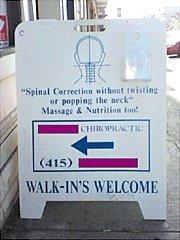Whenever I go anyplace in California, I am drawn as if by a magnet to any chiropractic office I drive or walk past. I have taught at each of the two chiropractic colleges in the San Francisco Bay Area.
So when I'm in the Bay Area, I simply must find out who the chiropractors are and what type of practice they have developed. By simply looking through the window of an office (as I rarely go so far as to actually step inside), I can get a sense of the kind of doctor they are and what techniques, what specialties and what type of promotional style is practiced.
On one occasion, I was peering through the window of an office I thought was closed, when the doctor suddenly walked out beaming and exclaimed, "Hello, Dr. Cooperstein!" This came as something of a shock for two reasons: first, I look more than a little different from how I looked when this doctor last saw me 23 years ago; and second, this doctor was one of two who threatened to kill me during my own student years when he was a chiropractic student himself. I guess he isn't mad at me anymore.
He proceeded to chat with me, sharing his sense of the best bars and restaurants in this district of San Francisco. I must say, he is a lot more charming now than when he was a student. Seeing him reminded me of when I had brought the written death threat to a senior administrator at the college, whose only response was to chuckle and declare "That R____, he's going to be a great chiropractor someday!" And maybe he is; I only know he has been successful in staying in practice in a competitive, high-rent city and I am happy for him.
 On another occasion, I was walking down a very busy street in a neighborhood district; a vibrant street known for its abundance of small shops and heavy foot traffic. From a distance, I noticed a sandwich-board sign with a very chiropractic-looking skull symbol. When I got closer, I recognized some familiar names on the signage. These people had not threatened to kill me two decades ago, but in fact, had been friends of mine. But the message on their sandwich board (See Figure) threatens to kill all of us (as chiropractors) by promising "Spinal correction without twisting or popping the neck." Judging from the nasium X-ray on the board, I assume this office is promoting a light-force upper-cervical technique, such as the National Upper Cervical Chiropractic Association (NUCCA) recommends.
On another occasion, I was walking down a very busy street in a neighborhood district; a vibrant street known for its abundance of small shops and heavy foot traffic. From a distance, I noticed a sandwich-board sign with a very chiropractic-looking skull symbol. When I got closer, I recognized some familiar names on the signage. These people had not threatened to kill me two decades ago, but in fact, had been friends of mine. But the message on their sandwich board (See Figure) threatens to kill all of us (as chiropractors) by promising "Spinal correction without twisting or popping the neck." Judging from the nasium X-ray on the board, I assume this office is promoting a light-force upper-cervical technique, such as the National Upper Cervical Chiropractic Association (NUCCA) recommends.
Knowing this street well, I can guarantee that thousands of people walk past this sign every day, and many will read the text. I suppose a certain small percentage of them will stop to ask for a brochure or even talk to the staff. The people who read the sign and keep on walking are given the suggestion that other, presumably bad chiropractors twist or pop the neck. Well, if performing a modified rotary break adjustment (a supine-distal-index-finger-pillar-push move, in NBCE-speak) is bad, then I guess I am one of those bad chiropractors. However, I have performed this adjustment with great success over the years - if this be bad, then let us make the most of it.
Right now, the stroke issue has this profession reeling, especially in Canada. No matter how many articles we publish emphasizing the rarity of post-manipulative strokes, what likely sticks in the public's mind is the attack, rather than the profession's response (which is seen as obvious and purely defensive). It seems human nature to find bad news more interesting than good, and so chiropractic adjustive procedures are seen as guilty until proven innocent. I don't think our situation would be nearly as pernicious were it not for a contingent of chiropractors who attempt to increase their market share by impugning the safety and effectiveness of those who use other technique methods. Hundreds and maybe thousands of people a day seeing this sign are made less likely to enter the market for chiropractic services, almost subliminally.
Many years ago, I stopped at a supermarket near my office to buy fruit for lunch. I found the market to have been blitzed by a former friend of mine from chiropractic college who had placed her tri-folded brochure all over the market from the meat section to produce. She had become a Directional Non-Force Technique (DNFT) practitioner and her brochure, like the NUCCA sandwich board, advised the public that chiropractic techniques other than DNFT were dangerous because they twisted and popped the neck.
I have heard and read Gonstead doctors attacking rotation as if they had data showing this vector produced spinal mayhem. (They don't.) I have equally heard and read sacro occipital technique (SOT) doctors advising how dangerous it is to manipulate the sacroiliac joint. (It isn't.) And some doctors claim that instrument adjusting is safer than hand adjusting, as if hand manipulation were dropping patients like flies. (It isn't.)
The claim that using any chiropractic adjustive method is "safer" than another method implies that other things are more "dangerous." But is there any adjustive procedure that is shown to be even marginally unsafe? Now, common sense dictates that for certain patients, a relatively low-force method may be safer than a high-velocity low-amplitude (HVLA) thrusting procedure. However, one must be very careful in how one makes such claims, for fear of putting the entire profession in a bad light. With this profession under attack, it is imperative that no chiropractors try to improve their position at the expense of everyone else's credibility.
There is no certainty that promoting chiropractic and putting it generally in a positive light will dramatically increase utilization, but I am certain that continuing technique fratricide will decrease it. Those who would close this profession down no doubt draw considerable encouragement and inspiration from those within it who cannot see past their own sign. The issue is not only an ethical one, but a matter of professional health.
Click here for previous articles by Robert Cooperstein, MA, DC.





